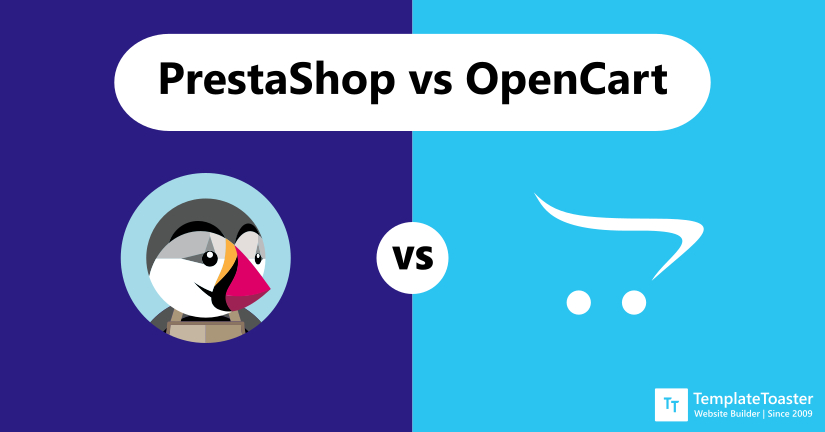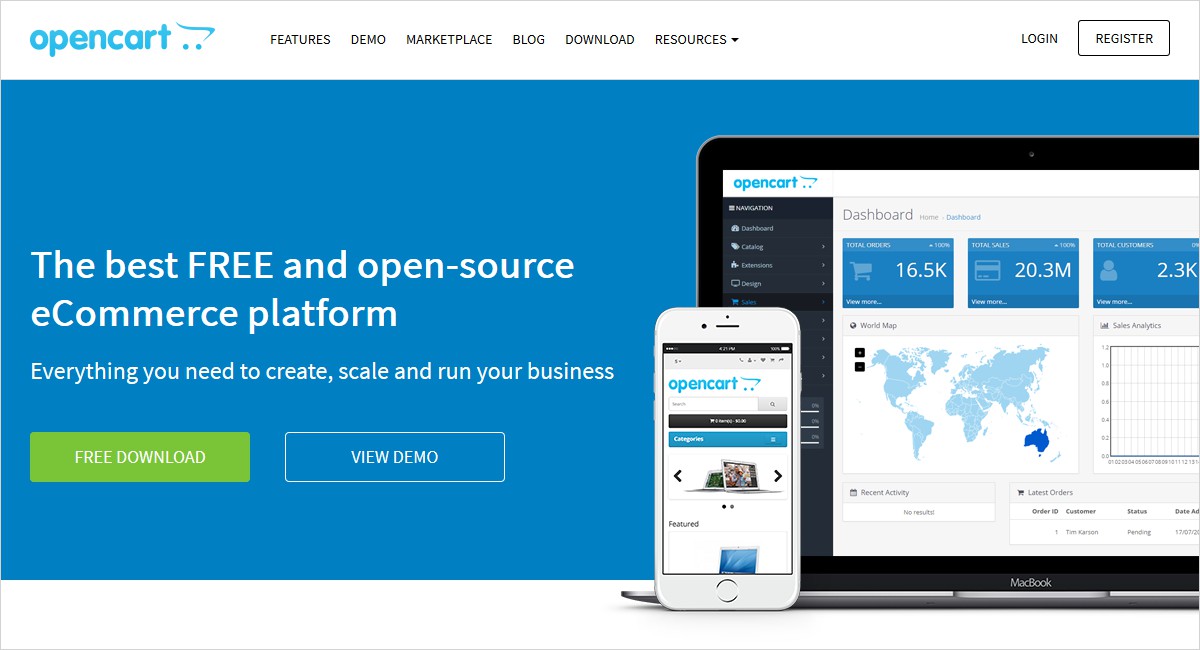PrestaShop vs OpenCart Differences

The success of any business now immensely depends upon its online presence. This is the reason most small, medium, and even large retail stores are going online. There are various platforms available to support eCommerce stores. However, choosing the right eCommerce store can be a real brainer. Therefore, I brought you this article to compare two major eCommerce platforms: PrestaShop vs OpenCart.
Every online store has its own set of unique requirements. To get the ideal platform, you should be aware of the basic differences. Read this blog post to understand the services offered by two well-popular eCommerce platforms, i.e. PrestaShop vs OpenCart. I will compare different facets of these two successful digital commerce platforms. By the time you’d be done with this blog post, you will have precise knowledge for choosing the right platform as per your business needs.
PrestaShop

PrestaShop was first introduced in 2007 as an open-source and cloud-hosted eCommerce solution by Bruno Leveguew & Igor Schlumberger. It was well-received by its audience due to the free downloadable version. However, it still required them to pay for SSL certificates, hosting providers, and other models in order to set up your shop properly. Moreover, it required you to hire a professional developer that got technical skills in HTML, CSS, and PHP. However, with the advancement in technology, you now have platforms like TemplateToaster that offers PrestaShop theme maker along with a rich library of ready-to-use free PrestaShop themes. Here is a step-by-step guide on how to build a PrestaShop eCommerce store using TemplateToaster. Learn here to create a PrestaShop theme and read about best PrestaShop hosting providers.
Officially Prestashop offers around 10 free themes that come with the admin. The best part is PrestaShop allows a robust integration of payment gateways, accounting, ERP, couriers, and warehouses.
Pros and Cons of PrestaShop Solution
PrestaShop comes packed with a lot of advantages. However, like any other platform, it is not a perfect solution. Therefore, it has some downfalls as well. Let’s find out which aspects of PrestaShop are more tempting and which are not.
Pros
- A strong suite for SEO campaigns
- Open source and free eCommerce Website Development
- Enhances the overall performance and speed of your online store.
- A large online community to help you out.
- Open source and a flexible platform
- Offers the flexibility to choose between self-hosted and cloud-hosted app
- Perfectly suitable for newcomers and midline eCommerce businesses
- Supports multiple currencies and languages
Cons
- It may be free but you will end up spending more on the add-ons
- The hosted version doesn’t offer multi-channel features
- Limited third-party compatibility
- Comparatively slower platform
- Script architecture may hinder the developer from developing the cart further
OpenCart

OpenCart is a self-hosted eCommerce platform that was first introduced in 2009 by Daniel Kerr. It is one of the best open-source CMSs and offers a pretty basic range of eCommerce functionalities. It’s simplicity is perhaps what makes it appealing to the merchants launching their business on the internet for the first time. Moreover, it comes with free software updates and assistance. However, you can always get corresponding extensions for advanced capabilities for managing products, categories, or order processing. Furthermore, it offers considerable scalability with feature-rich and easy-to-use templates and themes. The robust eCommerce solution enables merchants to set up and run their business own online stores at a minimal cost.
OpenCart is known for offering amazing eCommerce specific features including powerful catalog functionality, good order processing mechanism, caching, and more, which makes it one of the essential eCommerce platforms. However, online store owners may have to invest in add-ons and extensions for improving the performance of their eCommerce store. Best part is there are platforms like TemplateToaster that allows you to create your own OpenCart online store along with a rich library of free OpenCart themes or you can create your own OpenCart themes using the OpenCart theme builder.
Pros and Cons of OpenCart Solution
Pros
- Offers a comprehensive set of analytics and metrics to analyze the performance of your online store, all via a dashboard.
- Compatible with almost all payment gateways, allowing you to offer multiple payment options to your customers.
- Supports a wide selection of languages, enabling you to offer an international presence.
- Integrates all major shipping methods
- Offers priority-based technical assistance.
- A lot of free add-ons and extensions available
- Supports over 13K modules to manage your store efficiently
Cons
- OpenCart lacks scalability as compared to PrestaShop
- May create multiple duplicate pages which can be a problem for your SEO campaign
- Extensions and modules are not always compatible
- An add-on extension is a must to update inventory
- Slower checkout process
PrestaShop vs OpenCart Comparison 2021

Here are some of the major differences between PrestaShop vs OpenCart. To keep it short and crisp, I have sorted all the information in a comparison table-
| Factors | PrestaShop | OpenCart |
|---|---|---|
| License types | Published under General Public License | Published under Open Source License |
| Founders | Introduced in 2007 by Bruno Leveguew & Igor Schlumberger | Founded in 2009 by Daniel Kerr |
| Programming | Programmed using PHP with MySQL Database; runs on Smarty Template Engine | Programmed using PHP with MySQL database and HTML components |
| Number of Plugins and Modules | Offers over 3,000 modules and a lot of free plugins. | Offers over 13,000 modules and themes. Each module is available for just $10 onwards. |
| Ease of Use | Fairly difficult for newcomers since it requires coding skills for set-up. Moreover, the modules are a bit complex and are suitable for large businesses only. | Fairly simple for beginners and midline businesses. |
| Userbase | According to PrestaShop, there are more than 270,000 stores running on it from 195 countries, partnered with the best web agencies. | According to the stats released by OpenCart, there are over 317,000 stores running on OpenCart currently. |
| Online community | Over 1,000,000 community members provide support. | Localized community forums and tech support. |
| Prominent websites built | Some of the notable PrestaShop users are McDonald’s, Harry Fay, Bolina Sail, etc. | Siliconindia.com, and Webimax, are some notable OpenCart clients. |
| Language/Localization support | PrestaShop admin panel allows adding more than 75 languages | OpenCart offers around 40 and growing number of languages |
| Suitable for Medium or large stores? | Suitable for large-sized online stores | Small and medium-sized store |
Features of PrestaShop vs OpenCart
Although all eCommerce platforms are supposed to offer similar features, yet they are not quite similar. Find out some differences between the features of these two platforms in this section-
Learning Curve
OpenCart offers a rather beginner-friendly platform that is easy to get started with. Moreover, it comes with a highly intuitive and well-thought interface that enables beginners with easy navigation. With the quick setup process and responsive interface, the learning curve is quite easy and suitable for non-tech savvy users as well. Furthermore, you can add products to your online store with ease.
On the other hand, PrestaShop comes with a rather steeper learning curve. It requires the users to put in some coding for the initial setup. However, after the setup, it is pretty easy to handle with a customizable frontend and easy-to-comprehend backend. Moreover, the solution comes with a sleek and modern dashboard that provides quick access to all the store’s settings.
Availability of Freelancer Developers Community
When it comes to open-source platforms, the word ‘free’ is not exactly what you might think. Yes, OpenCart is free to download. However, you can’t expect to run your entire store free of cost. For starting, you are responsible for hosting, domain registration, and security of your online store. Therefore, you can expect some expenses including web hosting, CDN provider, domain name registration, SSL certificate, and more. Therefore, the platform might offer a free downloadable version for freelancers and newcomers but they will still have to spare some expenses.
Just like OpenCart, PrestaShop is also free to download. Similarly, freelancers will have to invest in web hosting, paid modules, paid extensions, and themes. When it comes to availability to the freelancer developers’ community, it might not be the ideal solution.
Payment Gateways and Shipping Integration Support
OpenCart supports a lot of integrations in terms of payment gateways and shipping. Some of the major integrations it offers includes PayPal, MYOB AccountRight, Authorize.Net, Skrill, SagePay, WFDS, UPS, WFDS, Next Logistics, MailChimp, PayZippy, ShipWire, Eurostop, Visual 2000, and so on.
As compared to OpenCart, PrestaShop offers a rather less number of payment gateways and shipping integrations. Some of the major integrations include PayPal, eBay, Authorize.Net, Google Analytics, Simplify by Mastercard, WordPress, SEO Expert, Amazon Marketplace, Advanced Search 4, and more.
Speed
In terms of speed, OpenCart is slightly faster than PrestaShop. However, the speed of an online store depends on various factors including the number of products on the site, number of visitors housed, web hosting provider, and your overall site architecture. Therefore, there is no specific platform that is faster than the other one.
Ready to use Templates/Themes
OpenCart offers a wide collection of responsive eCommerce themes designed professionally. You can find both free and paid templates at its official Marketplace. Moreover, you can easily apply it to your store with the basic knowledge of HTML, CSS, and JavaScript. Perhaps it can be a bit difficult for beginners. However, there are plenty of third pastry resources like TemplateToaster, ThemeForest, etc.
PrestaShop also has an official marketplace that offers over 3,000 web templates. Moreover, it has a vast selection of customizable eCommerce themes that are of high-standard and offers an easy shopping process.
PrestaShop vs OpenCart: SEO
When it comes to SEO, OpenCart doesn’t offer anything exceptional. At the same time, it is not the worst. Basically, it offers all the essential features you may expect from a high-end eCommerce solution. Moreover, it enables you to get your store to the top of SERPs at the earliest possibility. Furthermore, store owners can assign meta keywords and descriptions to all product and category pages, header and title tags. In addition, the platform copes well with creating great SEO URLs out-of-the-box. However, you can always install plugins to boost your SEO.
On the other hand, PrestaShop offers a versatile set of in-built SEO features. It enables merchants to edit each page, generate SEO-friendly URLs, add high-ranking meta tags, rich snippets, and more to drive more traffic to their website. Basically, PrestaShop wins this round.
Country of Origin
OpenCart is a Hong Kong-based company and its main office is also located in Tuen Mun, Hong Kong. PrestaShop is a France-based company and its main office is located in Villebon-Sur-Yvette, France.
Bootstrap Version support
OpenCart currently supports BootStrap version 3. However, there is speculation that BootStrap 4 will soon be adapted into future OpenCart releases. On the other hand, PrestaShop offers seamless support for the latest version of Bootstrap, i.e. Bootstrap 4 alpha 6.
PrestaShop vs OpenCart: Monthly Maintenance Cost
Both OpenCart and PrestaShop are free platforms but you still need to pay for web hosting, domain registration, and security of your eCommerce store. When it comes to maintenance, you can expect to pay between $20 and $100 monthly for hosting, domain registration, security, performance, and customization for an OpenCart store. Similarly, with PrestaShop, you are expected to spend around $100-$500 a month. However, the sum is nowhere near accurate because hosting and other factors are up to you so it gets difficult to predict the expected sum.
Ease of Installation
Since OpenCart is a standalone eCommerce platform that can be installed in two ways- 1) manually and 2) using the single-click script installer. If you want a quick and easier installation, go for the single-click script installer. However, if you want to make customizations, go for the manual installation that offers a variety of customization options and features. Here is a step-by-step guide on how to install OpenCart.
PrestaShop, on the other hand, offers one-click installation. However, you need a web hosting server that has a one-click installation script. Moreover, there is a local installation available that is rather complex but allows you to check for updates, modules, test changes, on your computer without interfering with the live store. Here is a step-by-step guide on how to install PrestaShop and how to migrate from Prestashop to Woocommerce? You can check out what is New in Prestashop 1.7.7.2 Update?
Server Resource usage
OpenCart is known for its rather fewer server resource consumption. Since it is ideal for running a small eCommerce storage with limited number of products, it doesn’t require huge server resources. In contrast, PrestaShop demands huge server consumption. Most PrestaShop-based site owners prefer dedicated server hosting for ideal performance.
PrestaShop vs OpenCart: Final Words
Here is your detailed comparison of two well-popular eCommerce platforms: PrestaShop vs OpenCart. I covered an in-depth comparison chart along with the features, pros, and cons. I urge you to read the article thoroughly and choose the one that meets your criteria. For any doubt and query, you can reach out to in the comments below. I hope this article is helpful to you to pick the right platform for you!
Build a Stunning Website in Minutes with TemplateToaster Website Builder
Create Your Own Website Now